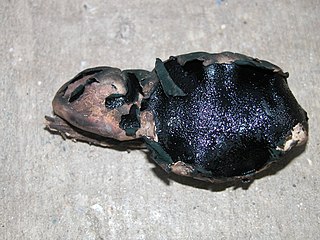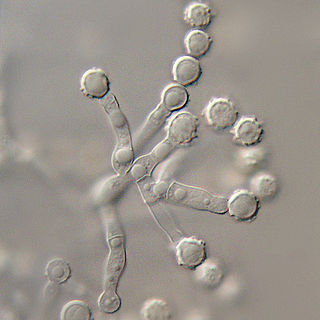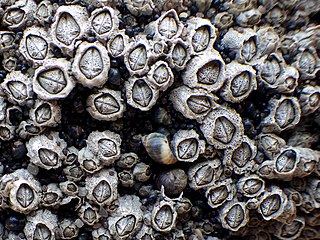
The Eurotiales are an order of sac fungi, also known as the green and blue molds. It was circumscribed in 1980.

The Hypocreales are an order of fungi within the class Sordariomycetes. In 2008, it was estimated that it contained some 237 genera, and 2647 species in seven families. Since then, a considerable number of further taxa have been identified, including an additional family, the Stachybotryaceae. Wijayawardene et al. in 2020 added more families and genera to the order. According to the Catalog of Life, As of April 2021 the Hypocreales contains 6 families, 137 genera, and 1411 species. Hyde et al. (2020a) listed 14 families under Hypocreales, while, Wijayawardene et al. (2022) accepted 15 families in the order, where Cylindriaceae was additionally added. Earlier, Hyde et al. (2020a) had placed Cylindriaceae in class Xylariomycetidae. Samarakoon et al. (2022) agreed. Hence, Cylindriaceae should have been excluded from Hypocreales and placed in Xylariomycetidae. Xiao et al. (2022) recently introduced a new family Polycephalomycetaceae to Hypocreales.

The Hypocreaceae are a family within the class Sordariomycetes. Species of Hypocreaceae are usually recognized by their brightly colored, perithecial ascomata, typically yellow, orange or red. The family was proposed by Giuseppe De Notaris in 1844. According to the Dictionary of the Fungi, the family has 22 genera and 454 species. In 2020, it was re-analysed and determined to have only 17 genera and about 658 species.

The Nectriaceae comprise a family of fungi in the order Hypocreales. It was circumscribed by brothers Charles and Louis René Tulasne in 1865. In 2020, an Outline of fungi was produced and listed 70 genera and about 1,336 species.

The Pucciniaceae are a family of rust fungi that cause plant diseases, mainly on cereals such as wheat. The family contains 20 genera and over 4900 species.

The Xylariales are an order of fungi within the class Sordariomycetes, subdivision Pezizomycotina, division Ascomycota. It was the original order of the subclass Xylariomycetidae. Xylariales was circumscribed in 1932 by Swedish mycologist John Axel Nannfeldt, and Xylariomycetidae by Ove Erik Eriksson and Katarina Winka in 1997. In 2020, more families were added to the order.

Pleosporaceae is a family of sac fungi. They are pathogenic to humans or saprobic on woody and dead herbaceous stems or leaves.

Sordariomycetidae is a subclass of sac fungi.

The Dactylosporaceae or Sclerococcaceae are a family of lichen-forming fungi in the class Eurotiomycetes. It is the only family of the order Sclerococcales and subclass Sclerococcomycetidae.

The Coccotremataceae are a family of lichen-forming fungi in the order Pertusariales. Species in this widely distributed family grow on bark or rocks, especially in maritime regions.

The Microascales are an order of fungi in the class Sordariomycetes, subclass Hypocreomycetidae. This is a relatively small order of mostly saprobic fungi that live in soil, rotting vegetation and dung. Some species are plant pathogens, such as Ceratocystis fimbriata, transmitted by beetles to living trees and causing cacao wilt and many other economically important diseases. Species in the genus Pseudallescheria are pathogenic to humans The order was circumscribed in 1980. Wijayawardene et al. in 2020 added more families and genera to the order.

The Microascaceae are a family of fungi in the class Sordariomycetes, subclass Hypocreomycetidae. The family was published by David Malloch in 1970, an emended description based on Everet Stanley Luttrell's original 1951 publication. Family was updated in 2020.

Herpotrichiellaceae is a family of ascomycetous fungi within the order Chaetothyriales and within the class Eurotiomycetes. It contains 16 genera and about 270 species. The type genus of the family, Herpotrichiella, is now synonymous with Capronia.
The Coronophorales are an order of fungi in the class Sordariomycetes. According to a 2008 estimate, the order consisted of 4 families, 26 genera, and 87 species. This was changed in 2020, it then had 6 families, with 46 genera.

Xanthopyreniaceae is a family of lichen-forming fungi in the order Collemopsidiales. The family was circumscribed by lichenologist Alexander Zahlbruckner in 1926.

The Boliniaceae are a family of fungi in the Boliniales order. The family consisted of seven genera and 40 species in 2008. A new study found more genera and species in 2020.
The Cephalothecaceae are a family of fungi in the class Sordariomycetes. The family was circumscribed in 1917 by Austrian naturalist Franz Xaver Rudolf von Höhnel. Species in this family are saprobic, often growing on rotten wood or on other fungi. They are known to be distributed in northern temperate regions. The family was placed in a monotypic class CephalothecalesHubka & Réblová in Index Fungorum 424: 1 (2019).

The Chaconiaceae are a family of rust fungi in the order Pucciniales. The family contained 8 genera and 75 species in 2008. By 2020, there were 8 genera and 84 species.

The Leptosphaeriaceae are a family of fungi in the order Pleosporales. The family was circumscribed by mycologist Margaret E. Barr in 1987. According to the Dictionary of the Fungi, the family contained 8 genera and 302 species. The family has a widespread distribution, but is especially prevalent in temperate regions. Species are either saprobic or grow as nectrotrophs on the stems or leaves of plants.

The Magnaporthales are an order of fungi within the class Sordariomycetes and subclass Diaporthomycetidae.

















